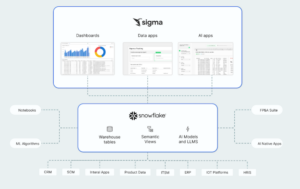
Source: Shutterstock AI-Generated
For all the advances in analytics, two problems continue to plague data teams: misaligned or inconsistent metrics across tools and the inaccessibility of unstructured data. These two issues not only slow down decision-making but also force teams to rely on manual workarounds – introducing inefficiencies, causing data drift, and increasing the risk of costly errors.
When teams define KPIs in different tools, such as dashboards, spreadsheets, and reports, those numbers often don’t match, undermining trust in the data. Meanwhile, critical business information remains locked inside PDFs, contracts, and other unstructured files that most BI platforms can’t access or analyze effectively.
Sigma, a warehouse-native BI and analytics platform, announced two major updates at the Snowflake Summit 2025 that directly address these pain points. In partnership with Snowflake, the company unveiled native support for Snowflake Semantic Views and integration with AI SQL, Snowflake’s breakthrough feature for querying unstructured data using large language models (LLMs).
These advances are designed to support governed semantic exploration and enable AI-powered analysis of unstructured files, directly within Sigma’s spreadsheet-style interface. Sigma positions this as a significant step forward in unified analytics as it allows users to query both structured metrics and raw human context side-by-side within a single governed system.
According to Mike Palmer, CEO of Sigma, the integration with Snowflake Semantic Views is “truly native” and is built for flexibility, scale, and the next generation of analytics. “By meeting the semantic layer where it belongs, we’re giving business teams instant access to governed metrics and logic without compromise,” explains Palmer. “And this is just the beginning. From bi-directional syncs to visual semantic exploration, Sigma is building toward a unified modeling experience that brings clarity and control to every layer of the data stack.”
 “This is a major leap forward in delivering a consistent, governed experience powered entirely by Snowflake,” added Palmer. “Sigma is building toward a future where every layer of the data stack speaks the same language – defined once, executed everywhere.”
“This is a major leap forward in delivering a consistent, governed experience powered entirely by Snowflake,” added Palmer. “Sigma is building toward a future where every layer of the data stack speaks the same language – defined once, executed everywhere.”
The company presents this integration as a way to streamline analytics by aligning business metrics directly with the data warehouse. It’s part of a broader push to ensure that everyone, from analysts to business users, is working from the same trusted definitions.
The collaboration with Snowflake also reflects a broader industry shift toward warehouse-native analytics. For Sigma, it’s a chance to help realize a long-standing goal in the data world: define your business logic once, keep it governed at the source, and make it accessible wherever it’s needed.
This means no more duplicating definitions across dashboards and spreadsheets. Instead, everything stays anchored in the warehouse, giving teams a single, trusted foundation to work from. That is one less source of confusion when teams need to move quickly and trust their data.
The other major update is Sigma’s support for Snowflake AI SQL, a new set of LLM-powered tools that make it possible to query unstructured content, like images, scanned receipts, product manuals, or contracts, just like how you would if they were rows in a table.
This upgrade pairs well with Sigma’s recently launched File Column Type, which allows users to upload and work with files directly in the platform. Paired with AI SQL, this opens the door to use cases that were previously cumbersome, like extracting payment terms from contracts or reviewing receipts as part of claims workflows. The new capabilities reduce the need for custom scripts, third-party tools, or manual data entry.
“For decades, legacy BI tools assumed your data was clean, structured, and waiting politely in rows and columns,” said Palmer. “But some of the most important business decisions are made with the messy stuff: legal documents, compliance PDFs, screenshots, receipts, product specs, and annotated images.
“Historically, those formats required a human in the loop: to read, interpret, and manually extract insights. That’s the bottleneck AI SQL removes. Sigma and Snowflake turn human knowledge into scalable systems, unlocking entirely new types of analysis across industries and teams.”
For Snowflake, the integration helps advance its vision of a unified, AI-powered data cloud. It validates its semantic layer strategy and showcases how third-party platforms can tap into Cortex AI SQL, without heavy engineering.
Carl Perry, Head of Analytics at Snowflake, said the integration “marks an important step forward in enabling enterprises to leverage the state-of-the-art AI solutions available with Snowflake Intelligence and Cortex Analyst,” adding that it helps teams “create more efficient and powerful workflows.”
The latest updates to the Sigma platform aren’t just about stacking on more features – it offers a glimpse into what modern analytics can be. With native support for Semantic Views and AI SQL, Sigma is showing how structured metrics and unstructured context can coexist in one interface.
Related Items
Why a Universal Semantic Layer is the Key to Unlock Value from Your Data
A Semantic Approach to Big Data Governance
AtScale Announces Major Upgrade To Its Semantic Layer Platform



